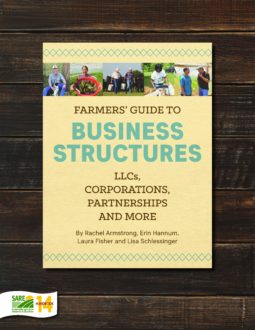This chapter covers the characteristics, tax benefits and various requirements of the S corporation tax status. It also provides a basic overview of certain tax procedures S corporations need to follow. The purpose of this chapter is to provide farmers with a basic understanding of what it means to run a farm operation as an S corporation. S corporations are deeply rooted in tax issues, and therefore the financial implications will vary depending on the specific financial situations of the owners as well as the farm operation itself. While this Guide is not intended to provide tax advice, it will provide a brief overview of tax issues that go along with S corporations. Farm Commons strongly recommends that farmers see an accountant or tax attorney for guidance in deciding whether the S corporation tax designation is best for their farm operation before electing S corporation status.
An S corporation is a federal tax status that is recognized by the IRS; it is not a state-created entity such as a corporation or an LLC. Before becoming an S corporation (or, rather, electing S corporation tax status) you will first need to create an entity in your state. If you decide you want to elect S corporation tax status, the entity options for your farm operation are pretty much limited to either an LLC or a C corporation. Be sure to read Chapter 4 on LLCs and Chapter 5 on C corporations to help you determine which is the best option for your farm business. Once you’ve created your entity–by filing your articles of organization (LLC) or your articles of incorporation (C corporation) with your state’s secretary of state office (or whichever state agency handles business creation documents)–you’ll then need to consider whether electing S corporation tax status with the IRS is ideal for you.
| General Concept | LLC with S Corp Tax Status | C Corporation with S Corp Tax Status |
| Name | "Farm Name, LLC" | "Farm Name, Inc" |
| Owners/Investors | "Members" | "Shareholders" |
| Persons who make management decisions are called | "Managers" (if manager-managed), "Members" (if member-managed) | "Officers" |
| Creation document is called | "Articles of Organization" | "Articles of Incorporation" |
| Organizing document is called | "Operating Agreement" | "Bylaws" |
| An owner's investment in the company is called | "Capital Contribution" | "Equity Investment" |
| An ownership share is called | "Percentage Interest" | "Shareholder Equity" or "Shares" |
| A payment of the company's profits to the owners is called | "Distribution" | "Dividend" |
| Is there personal liability? | Limited to a member's capital contribution | Limited to a shareholder's investment |
| General Concept | S Corporation Specific | |
| How many partcipants can you have? | Maximum 100 persons; all must be U.S. citizens and all must be human beings, estates, tax-exempt entities or certain qualified trusts | |
| Annual meeting required? | Required | |
| Different owner classes allowed? | Not allowed | |
| EIN necessary? | Required | |
| Taxation basics | Pass-through, but entity must file informational Form 1120S with the IRS, distribute Schedule K-1 to each owner and file all Schedule K-1s with the IRS | |
